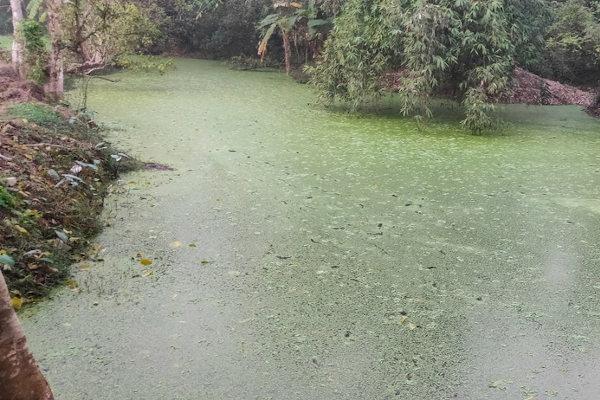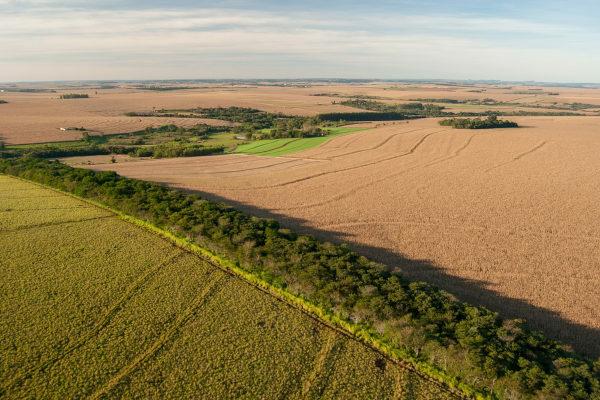THE eutrophication it is a phenomenon that occurs as a consequence of the increase in the amount of nutrients in the aquatic environment. can occur by natural causes, but it also happens as result of human action. It causes serious damage to the aquatic environment, such as the death of the species that live there and the proliferation of seaweed and cyanobacteria, which can produce substances harmful to health.
Read too: The relationship between environmental impacts and the emergence of diseases
What is eutrophication?
Eutrophication, from the Greek eutrophos, which means well nourished, is a process observed in different bodies of water and which is characterized by the nutrient increase, especially phosphorus and nitrogen, which causes excessive appearance of organisms such as algae and cyanobacteria. A eutrophic environment ends up acquiring a turbid color and the amount of oxygen decreases, which causes the death of several species.

Eutrophication can occur as a result of human action or even have a natural cause. Man can trigger eutrophication when, for example, he releases waste, such as the domestic sewage and industrial, or does the inappropriate use of organic fertilizers, which can be transported to the aquatic environment. This type of eutrophication is called cultural or artificial eutrophication.
This phenomenon can also have a natural cause, being observed, for example, in the normal course of aging of water bodies, since, over time, nutrients accumulate in the environment and favor the development of algae. Unlike cultural eutrophication, the so-called natural eutrophication occurs gradually and slowly.
The nutrient sources that cause eutrophication can be classified into two groups: diffuse and punctual. Point sources are those in which the supply of nutrients takes place in specific places, such as the discharge of sewage into rivers. Diffuse sources, in turn, are presented at different discharge points and can cover large areas. These last sources are more difficult to be controlled and also identified.
Read too: How is the river pollutions?
Do not stop now... There's more after the advertising ;)
Eutrophication steps
Next, we'll look at some important steps in the eutrophication process. It is worth noting that the process occurs slowly when we talk about natural eutrophication, but, in artificial eutrophication, events happen more quickly.

- Eutrophication begins with the increase in the availability of nutrients in the aquatic environment.
- With the greater amount of nutrients, there is an exaggerated appearance of the number of microscopic algae and of cyanobacteria, which form a layer that prevents the exchange of gases with the atmosphere and reduces the passage of light.
- As a consequence, the death of rooted plants and also of algae below the surface, once that the layer formed by algae and cyanobacteria prevents the passage of light and, consequently, the realization in photosynthesis. The death of these species reduces dissolved oxygen and also the availability of food for local species.
- The death of algae and plants increases the availability of nutrients for aerobic decomposers, which use the little oxygen present there in the process of decomposition.
- Decomposition accelerates the reduction of oxygen in the water, leading to the death of animals and plants alike.
- Then begins the anaerobic decomposition, without the use of oxygen, which triggers the release of gases that cause a strong odor.
Consequence of eutrophication
Eutrophication is a process that causes serious effects to the aquatic environment and can also harm human activity. See below some of the main losses of this phenomenon.
- Reduction in the amount of dissolved oxygen in the water, which causes the death of aquatic species such as fish.
- There are changes in the pH of the water.
- There is a reduction in the biodiversity of the affected area.
- There is an exaggerated increase in algae and other aquatic plants.
- Gases with unpleasant odors are released.
- Toxins appear in the aquatic environment, which are produced by some species of cyanobacteria. These toxins can affect human health and can even trigger death.
- The recreational potential of the aquatic environment is reduced.
- Fishing on the spot is reduced.
- Navigation and transport capacity in the area is reduced.
- There is a financial loss due to the high costs for the water treatment.
By Vanessa Sardinha Santos
Biology teacher
Would you like to reference this text in a school or academic work? Look:
SANTOS, Vanessa Sardinha dos. "Eutrophication"; Brazil School. Available in: https://brasilescola.uol.com.br/biologia/eutrofizacao.htm. Accessed on June 28, 2021.


